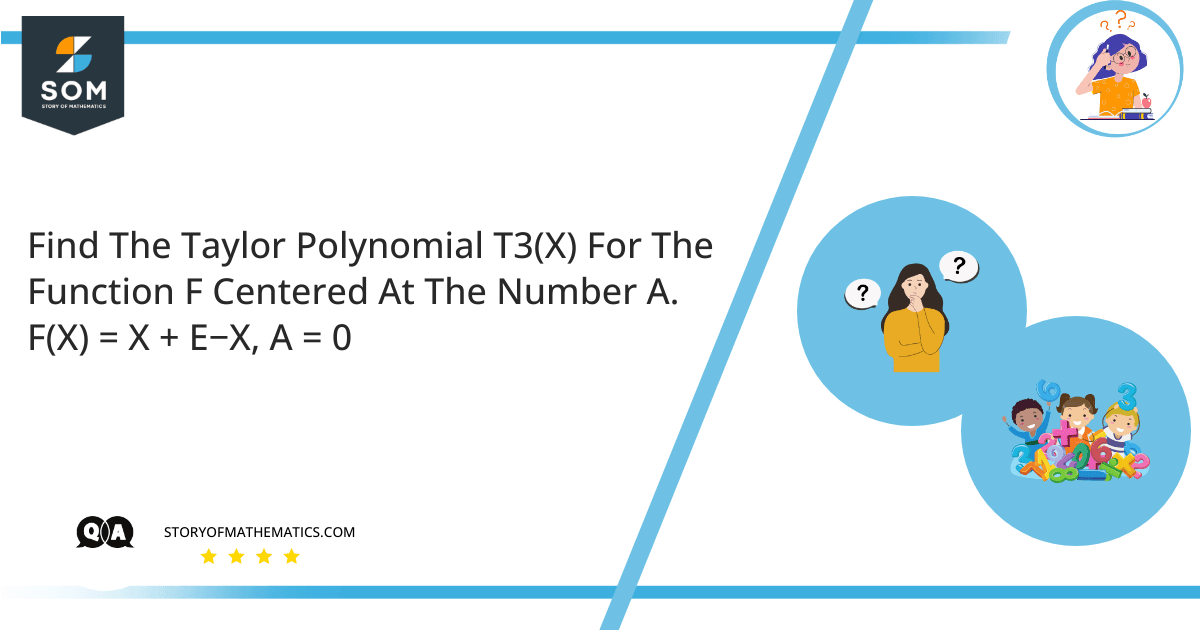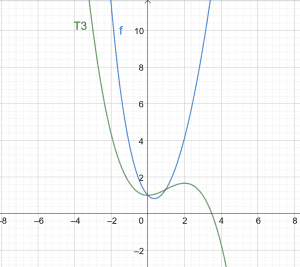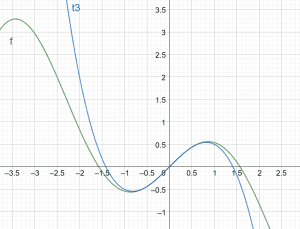
This problem aims to find the Taylor polynomials up to $3$ places for a given function $f$, centered at a point $a$. To better understand the problem, you must know about Power Series, as it forms the basis of the Taylor Series.
Taylor series of a function is defined as an infinite sum of derivative terms of that function at a single point. The formula for this Series is derived from the Power series and can be written as:
\[ \sum_{k=0}^{\infty} \dfrac{f^{k}(a)}{k!} (x-a)^k \]
where $f(k)(a)$ denotes the nth derivative of $f$ evaluated at point $a$ and $k$ is the degree of the polynomial. If $a$ is set to 0, it’s known as Maclaurin Series.
But not every function has a Taylor Series expansion.
Expert Answer:
Firstly, expanding the series for $k = 3$ as $T3$
\[ T3(x) = f(a) + \dfrac{f`(a)}{1!}(x-a) + \dfrac{f“(a)}{2!}(x-a)^ 2 + \dfrac{f“`(a)}{3!}(x-a)^ 3 \]
Next, we are going to find the derivatives of $f(x)$ which will get plugged into $T3(x)$ equation:
\[ f(x) =x + e^{-x}, f(0) = 1 \]
First Derivative:
\[ f`(x) = 1 – e^{-x}, f`(0) = 0 \]
Second Derivative:
\[ f“(x) = e^{-x}, f“(0) = 1 \]
Third Derivative:
\[ f“`(x) = – e^{-x}, f“`(0) = -1 \]
Substituting the above derivatives into $T3(x)$ becomes:
\[ T3(x) = f(a) +\dfrac{f`(a)}{1!}(x-a) + \dfrac{f“(a)}{2!}(x-a)^2 + \dfrac{f“`(a)}{3!}(x-a)^ 3 \]
Simplifying the equation:
\[ = 1 +\dfrac{0}{1!}(x-0) + \dfrac{1}{2!}(x-2)^ 2 + \dfrac{-1}{3!}(x-0)^ 3 \]
\[ T3(x) = 1 +\dfrac{x^ 2} {2} – \dfrac{x^ 3} {6} \]
Numerical Result:
Finally, we have our Taylor Series Expansion:
\[ T3(x) = 1 +\dfrac{x^ 2} {2} – \dfrac{x^ 3} {6} \]

Figure 1
Example:
Find the taylor polynomial $t3(x)$ for the function $f$ centered at the number a. $f(x) = xcos(x), a = 0$
Expanding the series for $k = 3$ as $T3$ gives us:
\[ T3(x) = f(a) + \dfrac{f`(a)}{1!}(x-a) + \dfrac{f“(a)}{2!}(x-a)^ 2 + \dfrac{f“`(a)}{3!}(x-a)^ 3 \]
Next, we are going to find the derivatives of $f(x)$ which will get plugged into $T3(x)$ equation:
\[ f(x) =xcos(x), f(0) = 0 \]
\[ f`(x) = cos(x) – xsin(x), f`(0) = 1 \]
\[ f“(x) = -xcos(x) -2sin(x), f“(0) = 0 \]
\[ f“`(x) = xsin(x) -3cos(x), f“`(0) = -1 \]
Substituting the above derivatives into $T3(x)$ becomes:
\[ T3(x) = f(a) +\dfrac{f`(a)}{1!}(x-a) + \dfrac{f“(a)}{2!}(x-a)^ 2 + \dfrac{f“`(a)}{3!}(x-a)^ 3 \]
Plugging in the values in $T3(x)$ equation.
\[ = \dfrac{1}{1!}x + 0 + \dfrac{-3}{3!}x^ 3 \]
Finally, we have our Taylor Series Expansion:
\[ T3(x) = x – \dfrac{1}{2}x^ 3 \]

Figure 2
Images/mathematical drawings are created with GeoGebra.
